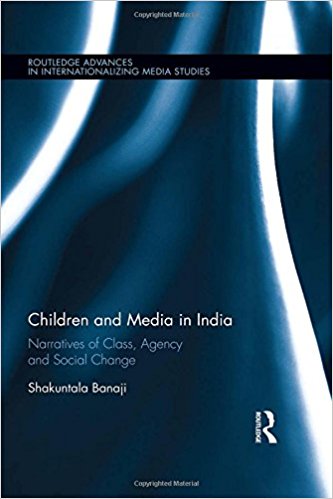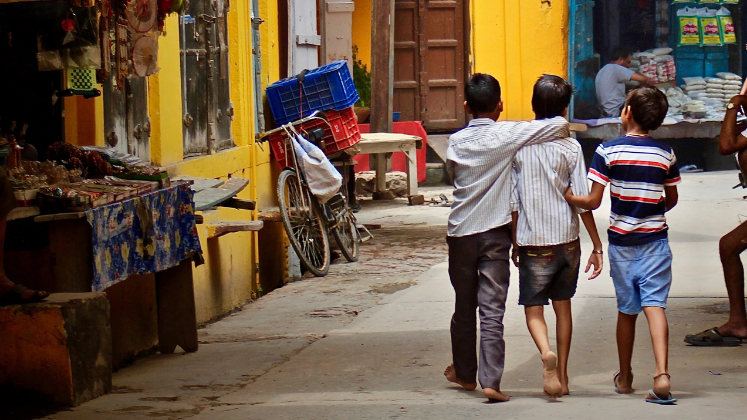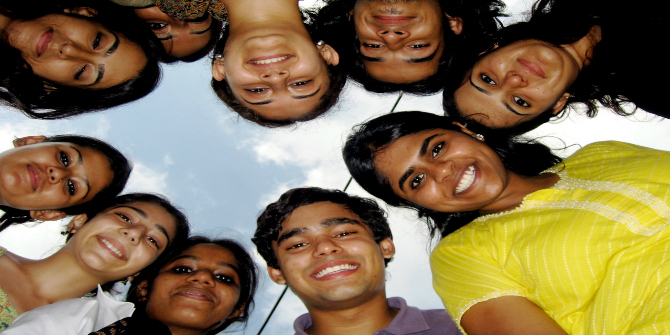In Children and Media in India: Narratives of Class, Agency and Social Change, Shakuntala Banaji draws on extensive fieldwork research to offer a rich and textured account of the place of media in the lives of children belonging to both the middle and working classes in India. Utsa Mukherjee is inspired by the conceptual and methodological sophistication of a book that challenges many longstanding assumptions regarding subalternity, children’s agency, intersectionality and power.
Children and Media in India: Narratives of Class, Agency and Social Change. Shakuntala Banaji. Routledge. 2017.
Understanding children’s lived experiences of the everyday and their own perspectives on different aspects of society was not a priority for social science research until the 1980s. The consequent growth of the ‘new’ social studies of childhood not only introduced conceptual frameworks to understand children’s position in society, but it also engaged directly with children – using their own words and narratives to make sense of their lives. This has led researchers to pay close attention to how children think and act within given contexts, and to grasp the notion of children’s agency. Unfortunately, works on Indian children and their everyday lives have been few and far between. Those that have been published in the recent past are almost exclusively about schooling and education or issues such as street children or child labour. As important as these areas are to understanding Indian society, Indian children’s use, interpretation of and representation in media have not received due attention.
Shakuntala Banaji’s new book, Children and Media in India: Narratives of Class, Agency and Social Change, achieves just this. Based on her extended, longitudinal fieldwork in India with children between the ages of nine and seventeen, she offers a rich and textured account of the place of media in the lives of children belonging to both the middle and working classes. She charts children’s use and interpretation of both old and new media in these two classes or, as she puts it, in ‘media rich’ and ‘media poor’ contexts. Often, studies on childhood and media end up focusing on class only in terms of purchasing power and access to media. But in this study, class overlaps with caste, religion and geography to implicate the intersectional identities of children. According to Banaji, class is not just a rigid social structure, but it also ‘works through the material life and embodied experiences of adults and children to galvanise and to stifle’ (71).
The primary sources of data in the study are from ethnographic observation and interviews with children. Supplementing these is a critical content analysis of popular Hindi films and television programmes through which Banaji attempted to understand the (non-) representation of children and childhood from different castes, classes, religions and genders. A content analysis of 163 children’s television programmes captured in one week of June 2015 reveals that working-class, Dalit or religious minority children are conspicuously under-represented in content made in India. Notwithstanding the acknowledged lack of space, one is left wondering if this analysis could have been developed beyond whistle-stop summaries of Indian children television’s engagement with language, genre, gender, religion, caste and class to offer a more detailed, complex and multi-layered account here. A series of ‘expert’ interviews with producers of content for and about children, as well as with relevant NGO officers, are then brought to bear on the content analysis, which helps to reveal how diverse discourses around childhood co-exist within Indian society and that separate groups of individuals from their particular social location have different set of ideas concerning different groups of children.
Banaji’s empirical accounts show how middle-class children in India increasingly have access to internet-based applications, computers and smartphones, but they also engage with ‘old media’ such as music on the radio and music videos on television. For some, online messaging services and cross-platform old media are integral to the ‘infrastructure of everyday life’. Issues around privacy, anxieties about romantic relationships being ‘discovered’ from chat history or about battery or credit running out also feature in their narratives. These children display political awareness, and the upper caste children often ranted against the government’s reservation policy for under-privileged groups. A small number of boys of fourteen years or above shared lewd and misogynistic images, videos and memes, and the researcher at times had to don the role of an activist interviewer when following up on their responses. Two queer children also feature in these discussions, who describe finding resources from the internet helpful. As one boy who stated that he was gay to the interviewer said: ‘Internet gives me life, it gives me hope, I find others who think like me’ (140).
The ‘media poor’ children from India’s working classes have a complex relationship with forms of media and tools of communication. Some divide their days between household chores, work and school. For others, schooling is not a viable option. Many of them like listening to songs on the radio or aspire to visit a movie theatre. Far from remedying these challenges, mobile technologies are at times seen as a distraction and risk by some children who work for a living. A 15-year-old boy recounts how he got a scar on his hand as he turned to check on his phone while working at his father’s fried food stall, leading him to stay away from phones while working.
A Dalit child’s poignant story also brings home the subtleties of the scenario. Ashok used to walk for two hours to attend a village school, but after the ‘food-to-study’ programme was discontinued, he started fishing in the lake. His part of the village has no schools, no computers or internet connection, and no mobile masts. He has no access to a television or a telephone, and he tells the interviewer: ‘What would I do with a phone or computer? Here is no signal. But if you give me food. I will take food. We will thank you’ (183). He wants a bicycle as he thinks access to it will let him ‘find out about the world’ and give him status. It is, for him, a form of technology to be used for transportation and communication: a communication technology. But Banaji goes further and refutes any simplistic reading that might suggest working-class children in India need food and bicycles over cameras or mobiles. It is not an either/or scenario, where needs or usage could be hierarchised without addressing entrenched structural problems. This is where Banaji’s analytical brilliance lies.
The study challenges several taken-for-granted ideas and stereotypes. To begin with, international development narratives often posit Information and Communication Technologies (ICT) as a panacea for all development-related issues in the Global South. Though knowledge of and access to ICT are important, in themselves they cannot remedy the deep-seated problems and violence emerging from casteism, patriarchy, free market capitalism and right-wing politics.
Moreover, a particular rhetoric about Global South children seems to circulate across development campaigns, technology companies, television shows and even media research, which posits the girl child as a victim and perpetually at risk while at the same time celebrating the ‘Indian-child-as-ICT-empowered-brand-conscious-entrepreneur’. Such a rhetoric, as Banaji shows, is superficial and creates a reductive account of the vast and complex intersectional identities of children in India. Though ICT might empower some children, it is a folly to frame all children as ‘digital natives’ or to talk in terms of ‘digital childhoods’. Similarly, risks do not act as a great equaliser. Those presumed to be applicable to children in much of the middle-class Global North are not immediate or relevant to most of the 300 million Indian poor and working-class children, whose lives are beset with other pressing risks and hazards.
Besides problematising current debates around ICT and development, Banaji offers original contributions to the theorisation of children’s agency. Rather than conceiving of this as an innate quality, she coins the term ‘ephemeral agency’ to argue that agency is expressed within particular contexts and through a range of actions on a spectrum of conformity and resistance. Children’s agency is not only embodied but is curtailed and intermittent, just as any adult’s, and exists as a potential rather than an essence. Banaji’s empirical accounts clearly show that class and caste also overlap as dominant structures in the lives of Indian children, as gender continues to inflect the display of agency in defined class contexts.
The conceptual and methodological sophistication that this book displays is inspiring in more ways than one and can prove to be a watershed as far as social research with Indian children is concerned. Banaji makes original and thought-provoking contributions not only to the specific field of childhood studies, media and communications, but also challenges many long-established and taken-for-granted theoretical positions regarding power, subalternity, intersectionality and children’s agency.
Note: This review gives the views of the author, and not the position of the LSE Review of Books blog, or of the London School of Economics.
Image Credit: Photo by Charu Chaturvedi on Unsplash.


 Find this book:
Find this book: 






1 Comments